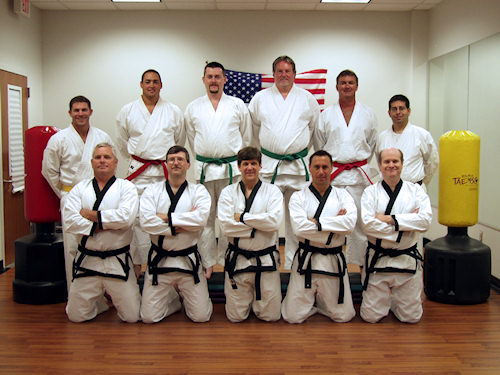A History Of Tae Kwon Do
Tae Kwon Do, sometimes called “Korean karate,” is the Korean martial art. It means, literally, “The Art of Kicking and Punching,” and it is derived from more primitive techniques of hand, foot and head fighting that were used in Korea as early as the first century of the Christian Era.
There are mural paintings found in royal tombs built between the years 3 and 427 A.D. showing two men in Tae Kwon Do postures, and these are taken as evidence that the fighting art was known during the Koguryo Dynasty, founded in 37 B.C. The Shilla Dynasty in southeast Korea was roughly contemporary with the Koguryo Dynasty, eventually conquering the latter, and at Kyongju, the ancient capital of Shilla, there is a stone Buddha sitting in meditation, guarded on each side by giant statues in Tae Kwon Do stances.
According to legend, the founder of Korea was Tan-Gun and historical records indicate some form of cultural activity for nearly 5000 years. From 57 B.C. -668 A.D three different Kingdoms struggled for supremacy of the Korean peninsula until the Paekche and Koguryo Kingdoms were conquered by the Shilla Kingdom in 668 A.D. thus unifying the Korean peninsula.
During the Shilla Kingdom the Korean kings established a close relationship with the emperors of T’ang China which resulted in a period of cultural renaissance for the Korean people. About 1,400 years ago, in the reign of Chin Heung, 24th king of Shilla, the young aristocrats of the country formed an officers’ corps to defend their kingdom, and called it the Hwa Rang Dan. The Hwa Ran Dan established a system of training that included the teaching of Chinese classics, history, philosophy, religion, and the philosophy and application of military skills. They developed the primitive hand and foot techniques of fighting by watching the natural defense and offensive postures of wild animals, and formed a harmonious system called Soo Bak Hee, or sometimes Tae Kyun. Men of virtue were often selected from this group to serve as statesmen and military leaders. It was through the valor of the Hwa Rang Dan that the Shilla kingdom was able to unify Korea.
In 918 A.D. a popular movement against the Shilla Kingdom was organized by General Wang Kon and in 935 A.D. the Shilla King surrendered. This marked the beginning of the Koryo Kingdom which ruled until 1392. The enlightened Koryo Kings once again encouraged the arts and during the period the popularity of the Buddhism grew. It was in the Koryo period that the “Tripitaka Koreana” were published on more than 80,000 hand-carved wooden blocks. The writing on the blocks is carved as a “mirror image” for printing and the production took 16 years (1011-1027) to produce. The martial arts system developed by the Hwa Rang Dan was called Soo Bak Hee, or “The Art of Kicking, Punching and Butting.” During the Koryo Dynasty from 918 the 1392 A.D., it was encouraged as a sport and health activity and there is evidence that it was popular as an entertainment. This popularity of Soo Bak Hee continued into the Yi Dynasty, and King Chongjo published an illustrated textbook on the martial arts that included Soo Bak Hee as training for military personnel
In 1392, the Koryo Kingdom was replaced by the Chosun Kingdom. It was during this period that King Sejong instructed his scribes to develop a system of writing for the common people. The scribes developed a 28 letter alphabet called han-gul. A 24 letter version is still in use today. In the last half of the Yi Dynasty, the royal court became disturbed by the strife between political factions and limited Soo Bak Do to a recreational activity. After the Sino-Japanese War of 1894, up through World War II, Korea was involved in continuous military conflicts between China and Japan, and Soo Bak Hee took in some influences from foreign styles, such as Japanese karate and Chinese kung fu. It began to be called Tang Soo Do, “The Art of the China Hand.” Other names were applied to its different styles, such as Kong Soo, Kwon Bop, Tae Soo, etc. During the latter years of the Chosun Kingdom, Korea practiced isolationism due primarily to the aggression of it’s neighbors. . The Chosun Kingdom ended in 1910 when Japan finally succeeded in annexing Korea.
After the liberation of Korea from Japan in 1945, there was a movement to find the origins of the art and unify it, and in 1955 it was formally named Tae Kwon Do. The art became an affiliate of the Korea Amateur Sports Association in June 1962, and was organized as the Korean Tae Kwon Do Association in August 1965. In 1988 Tae Kwon Do was included in the Soul Olympics as a demonstration sport.
THE FIVE STYLES OF TAE KWON DO
- mu duk kwon
- chung mu kwon
- chung duk kwon
- sang mu kwon
- oh duk kwon
